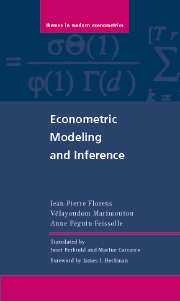Book contents
- Frontmatter
- Contents
- Foreword
- Preface
- I Statistical Methods
- 1 Statistical Models
- 2 Sequential Models and Asymptotics
- 3 Estimation by Maximization and by the Method of Moments
- 4 Asymptotic Tests
- 5 Nonparametric Methods
- 6 Simulation Methods
- II Regression Models
- III Dynamic Models
- IV Structural Modeling
- Bibliography
- Index
5 - Nonparametric Methods
- Frontmatter
- Contents
- Foreword
- Preface
- I Statistical Methods
- 1 Statistical Models
- 2 Sequential Models and Asymptotics
- 3 Estimation by Maximization and by the Method of Moments
- 4 Asymptotic Tests
- 5 Nonparametric Methods
- 6 Simulation Methods
- II Regression Models
- III Dynamic Models
- IV Structural Modeling
- Bibliography
- Index
Summary
Introduction
Nonparametric methods have recently taken a prominent position in econometrics. One of the essential reasons for this phenomenon is the increasingly frequent use of survey data and administrative data bases in microeconometrics (analysis of labor market, individual consumption, household saving). These samples are often very large. Although the microeconomic theory is well advanced, it does not provide a precise functional form that could be used for the statistical modeling. It is known that a relationship is decreasing or that a distribution has a decreasing hazard rate, but the economic theory does not specify the parametric form of the relationship or distribution.
Nonparametric methods are actually numerous and we will cover only part of them, we will neglect, for instance, rank analysis to focus mainly on smoothing techniques. These methods can be considered “descriptive.” However, this analysis of the observations is essential. Moreover, we will see that nonparametric methods extend to semiparametric methods that have as a purpose the estimation of a parameter vector without imposing restrictive specification assumptions.
Note that the treatment of simulated data (see Chapter 6), for which samples can be made as large as desired, heavily uses nonparametric methods.
We focus our presentation on i.i.d. models. Extensions to dynamic models are obviously possible and are used, for instance, in financial econometrics. We will recall first the essential properties of the empirical distribution before studying the density estimation and introducing semiparametric methods.
Information
- Type
- Chapter
- Information
- Econometric Modeling and Inference , pp. 87 - 102Publisher: Cambridge University PressPrint publication year: 2007
